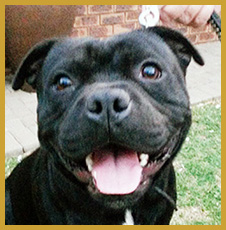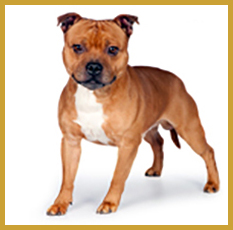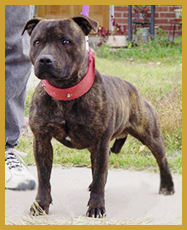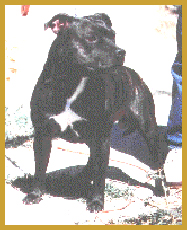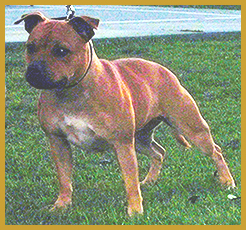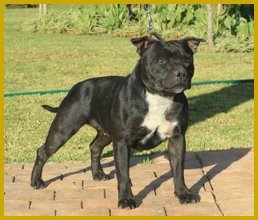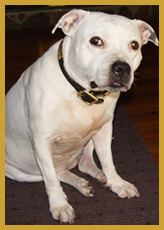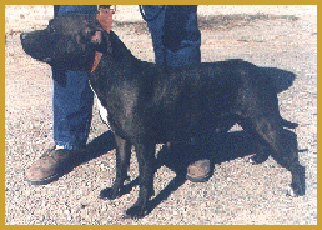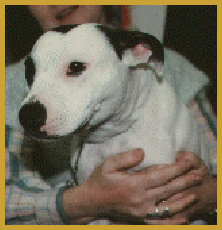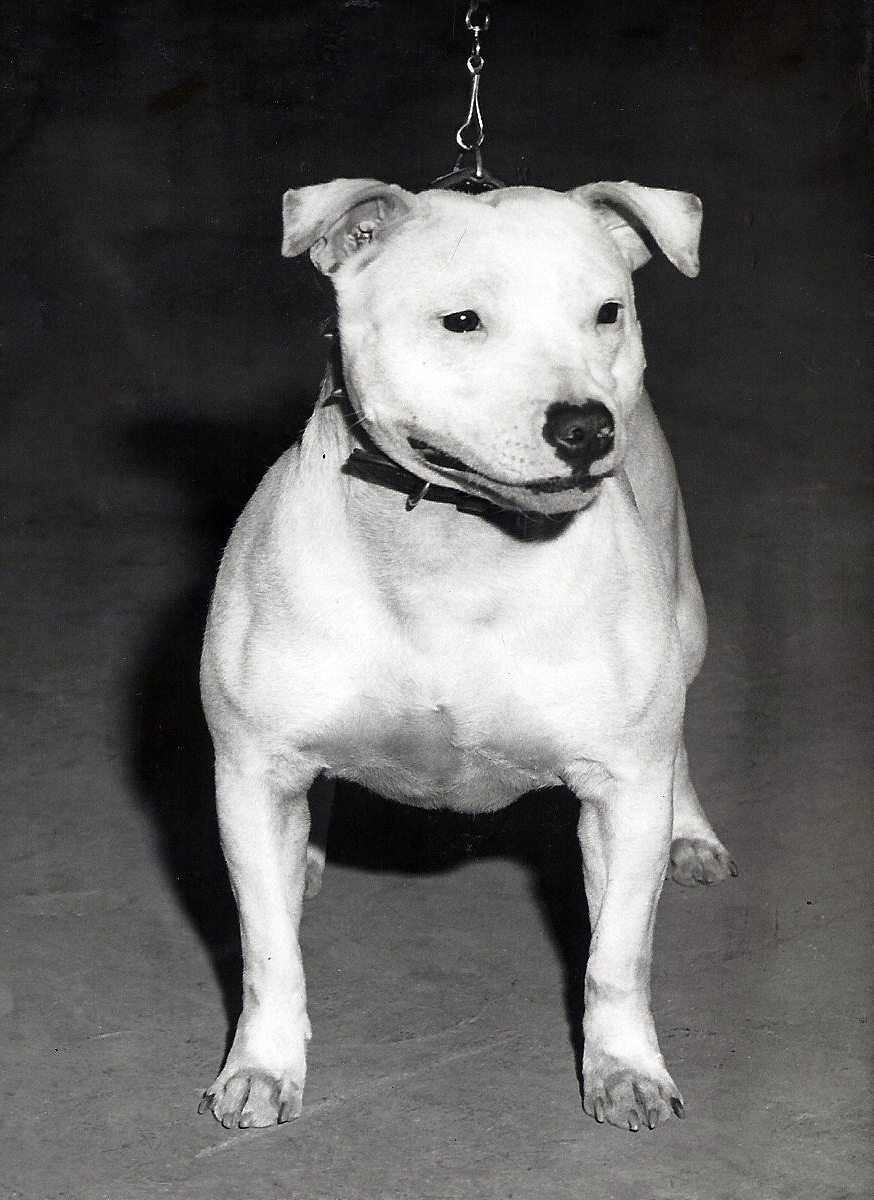Article 5
To: All Stafford enthusiasts.
Subject: 1998 Crufts Report (Long).
Here is my 1998 Crufts Report and Addendum.
I fell in love at Crufts:
That is, I did if it's possible to fall in love with all 12 entries in the Special Puppy Bitch class, individually, jointly, and simultaneously. Of such quality were they that if I had won the lottery and had been awarded my choice of the class as a prize, I would have had a genuine problem trying to choose.
All these twelve bitch puppies had size well within the Standard while still carrying adequate substance, they seemed to possess excellent temperament, and each one bore the unmistakable stamp of femininity in head and body. Needless to say, they were well conformed, and if any had a visible fault I certainly missed it. If they mature and fulfill their promise, the future of the Breed cannot be in doubt.
Not that the other bitch classes left anything to be desired, but senior classes depict the present while an outstanding puppy bitch class speaks for the future, possibly a decade or more. Seldom have I seen a sight more comforting.
Usually the dog classes, particularly the senior ones, receive most of the attention at ringside and in the doggy media, but serious breeders recognize that to an astonishing degree bitches determine how the Breed ultimately fares. Anyone who does not believe this may go to England with a full pocketbook and attempt to buy adult Staffords. Good proven males can be come by with a little luck, but finding a good bitch for sale requires divine intervention.
This year, unlike last year, I arrived early, before judging started, purchased the Crufts program, found that 317 Staffords were entered, and looked up the location of the Stafford rings (one for dogs, one for bitches). Donning my red N-Husker baseball cap (which looked silly in combination with my Harris Tweed jacket) so that Listers could spot me in the crowd, I scurried off to Hall 1 and plopped down on a vacant chair (shortly there wouldn't be any) in the row separating the two rings, hoping that every Lister ringside could spot my cap. (I was almost right.)
My interest in shows lies in the fact that they promote the Breed as a whole, so I pay scant attention to which individual exhibit wins what trophies. I bought a program but didn't mark it (never do), and I watched the exhibits intently to discover progress rather than individuals, trying to keep in mind that the 317 Staffords present represented about .0049053125 percent of the approximately 64,000 Staffords living in England (figuring 8,000 registrations per year, average lifespan of eight years) but also that the show ring has a disproportionate impact on breeding decisions.
My Panasonic Palmcorder, ideal for the weak lighting the Crufts venue offered, had fallen victim to the vagaries of a brand-new but nonfunctional replacement battery, so I unpacked my trusty Brownie and proceeded to watch and photograph the classes as they began. (I'll post about a dozen photos on the StaffPhotoList.)
After the Special Puppy Bitch and Special Puppy Dog classes were judged, my initial observation was that the Stafford population of 98 Crufts differed from that of 97 Crufts although it would be difficult to give specifics if pressed.
One of the immediate visible differences this year was that black brindles absolutely dominated the scene, and in no class was this more evident than the Special Junior Bitch class which had 24 entries under Judge W.J. Parsons, and by my informal count no fewer than 15 were black brindles. The judge then selected ten, all black brindles, from which to cut down to five finalists from which three top placings were chosen -- naturally all black brindles. A similar situation, although perhaps not so extreme, prevailed in the dog ring, and one could not help wondering how in the diffused shadowy Crufts light the judge was able to pick out any distinguishing features from any of these multifarious black creatures.
Perhaps word had got round that both judges liked a good black brindle (what's not to like?) or perhaps sunspots were responsible, but whatever the reason it's safe to say that the Breed in England is unlikely to be short of black brindles for a good long time.
Another minor but fascinating feature presented itself to those interested in such things, namely, a number of exhibits (usually black brindles, by the way) bore thin, pencil-sized tails falling a good way short of reaching to the point of the rear hock. I counted six in a single class, which caused me to wonder if they might be littermates. Tails such as these can hardly be counted a hazard to the Breed or even unsightly, but it isn't typical and might bear watching.
There seemed to be fewer exhibits displaying a feature on which I commented last year, namely, a muzzle inclining upward from the stop several degrees more than is typical, and of those few I did see none gained top honors. However, there seemed to be a slight increase in the number of exhibits that displayed what I call Boston Terrier eyes, i.e., round as the Standard requires but protruding which is non-Standard. I noticed a few exhibits who in profile view seemed to have a distinct stop at the juncture of the muzzle and skull but from a head-on view proved to have little stop, prominent eyebrow ridges creating the profile impression. I'm pleased to say that I saw only one exhibit possessing all three of these untypical characteristics.
With my previous (1997) concerns over upturning muzzles and a need for a more definitely feminine expression in bitches somewhat alleviated by this year's entries, my attention was caught by another aspect of muzzle shape, namely, an increasing number of both dogs and bitches exhibiting a muzzle displaying varying degrees of lack of substance from just below the eye all the way to the nose. The result is that when viewed from the front at eye level with the dog, the muzzle is narrow all along the bridge of the nose, but when viewed from above the dog's head it shows normal width and length. I don't know what to call this condition -- it's not snipyness in the traditional sense -- although I have heard references to a "pinched muzzle" without being able to discover precisely what was meant by that term. Regardless of the term, I would hate to see this condition spread and become commonplace.
Which brings up another point: since all exhibits had to qualify for to Crufts, a few British judges must be awarding prizes to relatively untypical Staffords. In any case, several British fanciers at ringside remarked about poor quality of judging at some of the smaller shows. This seems quite likely in view of the explosive growth in Breed numbers (about 8,000 KC registrations last year alone), in which case there could hardly be enough competent veterans to go around, and some lesser-quality judging must result. Even so, let me hasten to add that I could find no fault with the judging at Crufts itself.
An annoyance from last year presented itself again, Staffords barking. My credo is that a Stafford should be quiet as a snake even at a show, but I heard too much yappity-yapping again at ringside this year and found it hugely irritating. While the Breed seems to be edging toward the bully end of the spectrum in conformation, it seems to be leaning toward the terrier end of the spectrum in noisiness. (That rumbling sound I heard must have been Joe Mallen turning over in his grave.)
This year, as fate would have it, I had fewer opportunities to touch and handle exhibits, but those I did handle were not in what I would call hard condition. I feel sure that many exhibitors deliberately encourage surplus fat, weight which they hope will pass as substance in the judge's eye since many (most?) judges seem willing to settle for the appearance of substance if they can't find the real thing. Behind all this, of course, is the preference for a more "bully" type of dog, i.e., a look that looks impressive at first glance.
Most classes ran from 12 to 24 exhibits, and since overall quality was uniformly high the onlooker was hard put to select a favorite, particularly a greedy onlooker (myself) who would try to keep one eye on the bitch ring and the other on the dog ring, a heady but impossible task. Again, the presence of so many black brindles in Crufts's dim lighting compounded the problem.
Having dutifully donned my N-Huskers baseball cap and stationed myself in a highly visible seat between the two rings when I wasn't circumnavigating the area, I waited for other SBTListers to respond. Harry Carter was the first, but Harry had to show a bitch puppy for a friend so that our chat was perforce cut short. Before long Pierre-Louis Petite, he of the 24-Stafford domicile (this has to be a World's Record!) spotted the cap and introduced himself. His camera put my poor little Brownie to shame, so we talked dogs instead of photography, and I can only hope that he will share some of his Crufts photos with members of the SBTPhotoList. His English is excellent, and I thoroughly enjoyed talking with him although in the frenetic ringside atmosphere all conversations tend to be too cursory.
I next encountered Jim Holmes, not a List member but a friend whom I originally met at 1965 and 1966 Crufts and then again last year. Jim introduced me to his son who was showing a lovely red bitch and to his eight-year-old grandson who was the fourth generation of Stafford fanciers in the Holmes household. (Jim's dad had Staffords.) Now THAT'S what I call a family tradition!
As Jim and I were talking, a young lady in a Harley-Davidson cap showed up, and it turned out to be Rachael from San Francisco, a bit surprising in light of the fact that she had emailed me previously that she wouldn't be able to come to Crufts. In any case, it was delightful to meet her.
Then I located Vic Pounds who had coauthored the Stafford book with Billie Rant, and we mused on changes in the Breed and Breed owners since we first met at 1965 Crufts. Vic's wife also filled me in on Billie's present condition in a nursing home in Sussex where she is being extremely well cared for. Although Vic had assured me of this via transatlantic phone calls, it was somehow singularly reassuring to hear it in person. Then a couple of pleasant surprises. Richard Hopkinson introduced himself by suggesting a better camera angle as I was attempting some photography in the dog ring. He had been waiting for me to put in an appearance and informed me that another long-time acquaintance of ours, Steve Eltinge, was somewhere at ringside. Before long Donna Hopkinson appeared with Steve in tow, and he and I reminisced about the first-ever National Stafford Specialty Show in 1990 at Brookside Park, Pasadena, California, to which he as SBTC Inc. President had graciously invited me. We agreed it was nice to see that Staffords in the English ring are allowed to show at least an occasional "spark" without being politically incorrect.
Next Ron Delaney, formerly from Ireland but now from Orange, California, spotted the cap and came over for a brief chat. I was pleased to hear that he had several promising but pups to choose from to take home and that he was hoping to find a good young dog. He said that he had been talking with a young Chinese-American lady who was also looking for young stock, but in the rush of things I didn't get an opportunity to talk with her.
As a reconvened with Mr. and Mrs. Pounds, Tony Aveson and Jim and Cassie Malloy turned up, and for a while I was trying to carry on five conversations while keeping an eye on both rings. I'm afraid I didn't do a very good job with any of these tasks, but adding to the free-for-all atmosphere was Mervyn Thomas (Merv and I had frantically searched for each other at 1997 Crufts, to no avail) whom I was most delighted to meet at long last. As it turned out, Tony was in the process of purchasing Mac, part of the black brindle litter whose photos Merv has posted on the SBTPhotoList.
Next I ran into Pat Bryant who had just returned from a trip to Ireland, and she and I spent a good deal of time talking about SBTList threads and how Stafford judging in England was experiencing difficulties due to the great increase in Stafford registrations. Pat's extensive experience in the Breed and her incisive writing skills are a great asset to the List.
I may have made another convert to the List when I met Lady Julia Arburthnot, formerly from Scotland and now from southern France, on the train to Birmingham. Much to my amazement, she had heard of me. and, apparently, much to her amazement I am not yet in my dotage. The train ride from London to Birmingham International lasts nearly two hours so that we had plenty of time to compare notes. We might have talked even longer, but we agreed on absolutely issue that came up, which cut down on a lot of time-consuming bickering. A veteran of the Breed, she is now ready to get on the Internet, so naturally I told her about the List and gave her a couple of relevant email addresses to pursue. I trust we shall hear from her in due course.
But not every anticipated meeting was realized at Crufts. I failed to locate Juanita Hobbs to whom I owed and still owe a small sum for an ad in a SA Stafford publication nor could I find Sandra Smid of NZ for whom I had brought some heirloom doggy photos. All efforts to locate Nick Wheat went for naught, and Robert Simon seemed to have become the Invisible Man. (One fellow wearing a "SBTClub of the Nederlands" T-shirt claimed not to be Robert Simon despite my earnest efforts to convince him that he was.) Likewise Dave Orme proved far too elusive to find. I tried to find Bev Harrison half a dozen times without success, even going to the bench where Yorkstaff Guy Fawkes of Trawden was supposed to be tethered. No Guy Fawkes, no Bev! I also looked for George Newton although I wasn't certain if he was planning to be at Crufts, again without result. Karsten Tigemeyer was nowhere to be found because at the last moment he was unable to make the trip. Ah well -- next year?
Meeting all these new/old friends made 1998 Crufts infinitely more enjoyable than 1997 Crufts where contacts were missed (yet in its own way 1997 Crufts was terrific), the fraternal element of encountering List members adding a dimension to the Crufts phenomenon that must be experienced to be fully believed.
Stafford folk are the best.
Steve Stone
Crufts Addendum:
At Crufts I ran across Malcolm Boam whose acquaintance I had made in 1966, first at ringside (in London's Olympia Hall) and then on the day after when Colin Smith drove me to visit Malcolm's home in Staffordshire. Malcolm was the owner of Ch. The Black Monarch, my all-time favorite Stafford (other than my own, of course!), bred by Mr. Barker, a butcher from Staffordshire.
When I told Malcolm that The Black Monarch remains my favorite, he thanked me and said, "Yes, he was a grand dog for his day. But today is another day." I thought his reply a masterpiece of modesty.
I also had the good fortune to meet Mr. Barker at 1966 Crufts, and since he had bred all four generations behind The Black Monarch I asked him to tell me what criteria he has used to determine the matings.
A friendly and generous person, Mr. Barker proceeded to explain to me for some twenty minutes just how he had gone about it. However, his Staffordshire dialect delivered in a strong Staffordshire accent threw me for a loop. I could understand only every third word. So I stood there, listening intently, groping for clues, and saying, "Yes, sir" about every tenth word to keep him going, praying that at some point I would be able to pick up the thread of his conversation.
I never did. To this day I regret being so conscious of my status as the rankest of amateurs that I was to embarrassed to call for translating assistance.
John Gordon knew of my admiration for The Black Monarch, whom he himself appreciated, and provided me with two TBM daughters from different litters to take back to Finland with me. Both made their mark in the Breed there.
By my informal count, twenty-seven all-white or pied Staffords possessing white hair around the eye(s) participated at Crufts, and every single one had pink eye rims. (This anecdotal headcount is statistically irrelevant, if interesting.) As promised earlier on the List, I did ask a number of veteran Stafford folk if they knew of cases where Staffords with white hair around the eye had dark eye rims. Two were surprised that anyone would be interested, two said they had no such experience, one said that had seen one such exhibit (didn't specify, though), while yet another said that she never hoped to see one. (This last statement can be interpreted in different ways, so I'm not really sure of her meaning.) So much for research!
I broached the subject of Staffords being able to run with a couple of old-timers, mentioning that some List members feel that Staffords being able to run is unimportant or even undesirable. One, a third-generation Stafford owner, holds definite views on the subject: "It comes down to original purpose, you see. Nobody fights their Staffords now, in fact, nobody even wants to fight them, but fighting was the original purpose, and we want to breed a Stafford that could fight if given the chance. Whether we like it or not, that's what we must try to do. Now, the only way you can train a dog to condition him for the pit is by plenty of road work, just like a human prize fighter. Those who say that Staffords were not bred to run are wrong, dead wrong, because the old-timers ran their dogs until their [the oldtimers'] legs gave out. A Stafford that can't run is only half a Stafford." (I did mention that he holds definite views, didn't I?)
I must confess that I didn't even get the name of yet another old-timer who when he discovered my presence came up to me and embraced me like a long-lost brother. Turned out that we had never met, but he was a close friend of the late Len Pierce who had willed him his doggy correspondence among which were some letters that I had written about importing Brinsley Lad into the States. I had just moved from California to Nebraska in December, 1969, long before the AKC recognized Staffords, and was living temporarily in an apartment with my family and two Staffords while our new house was being completed when Pierce called, saying that he had obtained my phone number from John Gordon and that he (Pierce) was fed up with English judging because his outstanding dog Brinsley Lad had been awarded six Reserve CC's without receiving a single full CC's. He offered me Brinsley Lad (for a ridiculously low price) in the well-founded belief that the dog would be an invaluable asset to the our genetic pool, but I was in no position to take on another Stafford, particularly not a mature stud dog, so I gave him the name and number of Claude Williams of Ashton, Maryland, who I felt sure would want such a dog. Claude did indeed, and shortly BL became SBTC/USA registration #190. The discovery that Len Pierce had kept my letters was most touching.
One fancier gave me to understand that next year he intends to arrange Crufts tours originating from the States. If he's able to do so, it would greatly facilitate the trip for those American making their first trip to England and/or for those whose primary interest is in dogs. I assume it wouldn't be a Staffordfolk-only affair as it takes a lot of bodies to fill a modern jet plane.
Prices in England are ferocious by American standards, due, I believe, to devaluation and inflation. Example: in 1966, the price for a good Stafford pup was 15 Pounds while today the same pup might cost 350 Pounds (about 23 times as much). (The present rate of exchange is one Pound equals $1.70.) By comparison, in 1966, my price for an American-bred Stafford pup was $100.00 while today a more or less standard price might be in the $350-450 range, which just about keeps pace with inflation. (Naturally it's possible to pay a lot more for a Stafford pup in either country, but as P.T. Barnum was fond of saying......)
It appears that the US government maintains the exchange rate at an artificial level in favor of other currencies to encourage England and other countries to buy America's exported products and to discourage Americans from buying imports because the US has a perennial trade deficit amounting to billions of dollars every month.
I was obliged to leave Crufts early, about 2:00 PM, in order to catch a train to Birmingham New Street and another to York, to meet Maini and get a quick glimpse of Jorvik, the archeological digs of York's Viking period. It was fascinating. As it was, six hours of watching Crufts at maximum intensity runneth one's cup pretty darned close to over.
Besides, there's always next year!
Steve Stone
To: Carolyn & Terry Stewart
Subject: Crufts Photos
The lighting at Crufts does not favor amateur photography, but I was fortunate in being able to get several passable photos. What follows are captions/comments to accompany each photo as specified.
As those who have perused my 1997 Crufts report know, I expressed several concerns about the development of the Breed at that time and went to 1998 Crufts with the idea of photographing exhibits that showed those shortcomings. While there, I immediately realized that it would be exactly the wrong approach, so I looked for exhibits possessing correct virtues.
The photos:
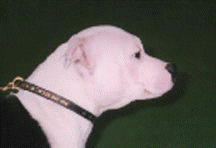
#1 - A pied dog with a white head showing against the background of the dark green carpet (simulating grass?). This dog in profile shows what I consider to be the ideal relationship between the angle of the head/skull and the angle of the muzzle as well as length of muzzle in relationship to length of skull. Although one cannot see the muzzle from the front in this profile view, the muzzle was equally correct. (One is seldom lucky enough in dog photography to get exactly the picture one is hoping for, but fortune was on my side this time.)
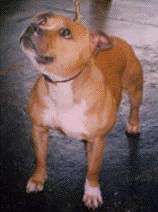
#2 - A young red bitch with what I consider to be the ideal feminine expression as she gazes adoringly at her owner. If you have to look between a Stafford's hind legs to determine its gender, something is very wrong. (Young bitches of this quality are not to be had save through divine intervention.)
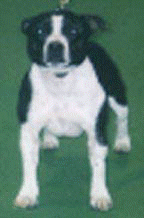
#3 - Want flashy markings? Crufts has something for everybody. It would be hard to miss this bitch in any crowd, and she would probably be a contender. White markings on the muzzle make it possible to see that she has good substance from under the eye to the nose.
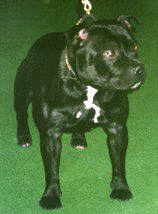
#4 - Don't like flashy markings? Crufts has something for everybody. This bitch seemed to one of a dozen near-clones populating the ring, but who could overlook quality like this?
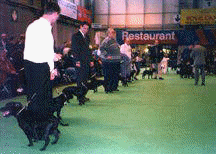
#5 - If you like black brindles (and who doesn't?), the Special Junior Bitch Class had to be your cup of tea. Of the 24 entries, at least 15 were black brindles, and all ten making the first cut were black brindles, so no guessing was needed to determine the coat color of ultimate winners.
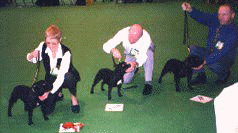
#6 - Top three placing in the Special Junior Bitch Class. How could one go wrong with any of these?
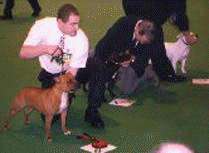
#7 - Just to prove that Judge W.J. Parsons was not committing the ultimate Stafford sin (judging by color), this photo shows the winners of a later bitch class : one red, one black brindle, and one all-white.
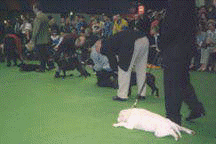
#8 - This photo from the dog ring shows a couple of interesting points: 1) how much more relaxed exhibitors and exhibits are in the British show ring, and 2) how much more visible an all-white dog is, particularly compared to the black brindles in the background and under poor lighting conditions.
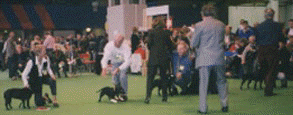
#9 - If you realized how hard it is to get good group photos at Crufts, you'd cut me a little slack when I try! :-) The final five in one class or another, all black brindles, of course.

#9b - Another attempt at photographing winners of a class.
You'll notice that the majority of my photos depict bitches, younger bitches, for they determine the immediate future of the Breed. If you want photos of the big-name winners, you'll have to go to Crufts next year and take them yourself.
And isn't that a great good excuse for making the trip?
Steve Stone
